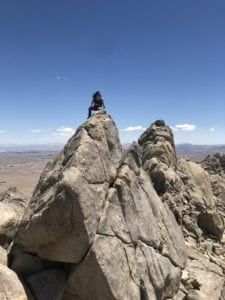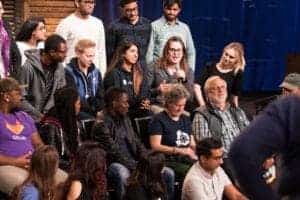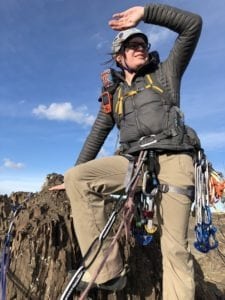Kris Nova, Heptio, sat down with Kim McMahon, Cloud Native Computing Foundation, to talk about cloud native, trends in the industry, and being an Ambassador. Below is their interview. You can also view the video.
Kim: Thank you for joining us for this Ambassador Interview. Kris, can you do a quick introduction?
Kris: Hi. I’m Kris Nova. I work for Heptio. I’m a developer advocate, contribute to open source Kubernetes, which I have been doing for two years. Last year, I joined CNCF as an ambassador and here I am.
Kim: Wonderful. Let’s start with a little bit about you. What do you like to do in your free time?

Kris: So when I’m not contributing to open source, which is a lot of my free time, I would say I’m usually climbing mountains. Mountain climbing, mountaineering.
Kim: Have you found much of that here?
Kris: Here, in Denmark, no, which I was kind of bummed. Every time there’s a tech conference, I’m always like, “Hrmm, I wonder if there’s any really great mountains nearby I could go climb.” There’s not much here, but Seattle (KubeCon North America 2018) has some good mountains.
Kim: I read tech news, you probably read tech news. What’s a good source for tech news that you’ve found, learning about the industry, or that you’re sharing?
Kris: My Twitter feed. 🙂
I sit next to Joe (Beda) at the office and he is a great resource. I feel like I constantly get a lot of news delivered to me on a silver platter because he usually goes through and finds all the good stuff and just tells me about it. I spend a lot of time on Reddit. I’m a moderator for the Golang Sub-Reddit.
I’m active in the Kubernetes Reddit as well. Twitter is a great source. A lot of my friends do the same thing where we’ll get hand picked tech articles that come our way on Twitter. I’m pretty selective about who I follow. So I think a lot of it comes through there.
Kim: Let’s get into a little bit of tech and talk about innovations and what do you see as next big things coming up in cloud native, containers, or open source.
Kris: I’m so narrow minded because I work in a very unique small section of open source, which is the Kubernetes infrastructure layer, what little bit of it is there. But I think the next big thing for me is looking at taking this idea that we can write cloud native software, like Kubernetes, to manage and mutate underlying infrastructure and taking that and building out Kubernetes self-deployment and Kubernetes autoscaling primitives with some of the work we’re doing in upstream like cluster lifecycle.
I wrote a book on it called “Cloud Native Infrastructure” and it kind of goes really deep down the rabbit hole on a lot of the stuff. But I’d say over the next year or so we could really start to see the software layers coming in and making infrastructure operators job much more elegant.
Kim: So is that taking it a step closer to the enterprise or do you think you’re there already?
Kris: I think we’re there philosophically or we have the ideas in place and I think we’ve all kind of done enough on our own to demonstrate that this stuff works. It’s now a matter of coming together as a community and saying, “Okay. How do we as an open source community, under CNCF, want to go through and actually solve these problems? And what is that going to look like? And what is the software tooling going to look like?” We’re at the proposal phase, which is the most exciting phase because that’s when everybody just gets to talk and say whatever is on their mind. I’m really happy right now.

Kim: You also mentioned that a lot of your time is taken up with things in the community.
Kris: I’m fortunate enough to where a lot of my day-to-day job is keeping up with the community. We have a lot of common interests as well. It’s kind of like a match made in heaven. So it works well together.
Kim: You mentioned keeping up with the community. What kind of things do you do besides the SIG that we talked about and contributing code? You’re the developer advocate so are there certain things that you really like doing in that role?
Kris: I’m the only developer advocate right now (at Heptio) and I came over from developer advocacy at Microsoft so the two ends of the spectrum where it’s an entire army of developer advocates versus like just little old me. A lot of what I’m doing is understanding what’s going on in the community and then what is the user experience like for people not only running the tools and using the software, but creating the software.
What that looks like and then advocating that back to the community, back to Heptio, connecting that together, and being that liaison. A lot of that even spans the scope of these open source meetings. Here at KubeCon, at other tech conferences, it’s at Meetups, kind of anywhere in the wild. Twitter is a great resource as well.
Kim: Wow. That’s great. So people are connecting at events, conferences, Meetups, and Twitter.
Kris: And I’m like the garbage collector. I just take all this noise, sleep on it, go climb a mountain, think about it, and, oh, I can make sense of it now and there’s this really important revelation I just had. And then go deliver that back to the community or our company.
Kim: We’re on the topic of cloud native. Tell me, what does cloud native mean to you and how would you explain it to somebody who’s new to this field?
Kris: That’s such a great question. What does cloud native mean to me? Well, I have a really weird definition, but I’m just going to say it because I feel like some people get a kick out of it. When I hear cloud, I think HTTP or probably HTTPS, which to me represents the Rest APIs and the interfaces that cloud providers put in front of whatever infrastructure you’re mutating or whatever services you’re mutating.
So whenever I think cloud, I think because it’s good old HTTP, I can interact with that with software. Instantly it goes from me connecting wires in a server room to Curl minus Capital SSL. It’s now this automatable thing. And native to me sort of implies that your application is reaction driven. We’re looking at our application within the context of the new way of doing things over HTTP and what does this new application need to look like?
What form does it come in? How is it different than before? What does the new shape of the application look like? Writing a cloud native application, to me, usually means writing it from scratch. Although there’s this really interesting concept of we’re not migrating to a cloud native application, how do we take this application that wasn’t designed to be run in this new way where everything is exposed over an interface and actually go and try and migrate that and turn that into a cloud native app.
So cloud native, it’s like this new way of thinking about apps and it just introduces a lot of new paradigms.
Kim: It does, yeah. Definitely. So you’re an ambassador. Why did you join? What do you like about the Ambassador Program?
Kris: I do a lot of work directly with folks at the Linux Foundation, folks at CNCF for the diversity committee, and I’m involved with the whole diversity scholarship effort in general. I’m constantly advocating for CNCF as part of my day job. I think it was just kind of a natural fit. I was doing everything that an Ambassador would normally have done without the actual Ambassador title.

Kim: Excellent. I have a couple word association for you. Ski or ride?
Kris: Technically I snowboard. So I guess it would be ride. I’m very strong against skiing or riding in mountaineering terms because if you walk up, you’re breaking ethics if you ski down. You’re cheating. You’ve got to walk down. That’s part of the game. There’s been a couple times I brought my snowboard up with me. But usually I’m like, “Nah. We gotta walk back down.”
Kim: Mountain climbing – indoors or outdoors?
Kris: Outdoors. Definitely.

Kim: Do you have a favorite place?
Kris: My favorite place to climb? So I just moved from Colorado and there’s 58 mountains there that are called the 14ers. 58 mountains that are 14,000 feet or taller. I climbed all of those and my favorite one is Little Bear. I free soloed Mount Rainier, which means I climbed it with no ropes or anyone else with me. And that was the most intense climb I’ve ever done in my life. So that’s probably my new favorite place.
Kim: How long did that take?
Kris: I was up there for three days.
Kim: Wow. Good for you. The last question – hiking or literally anything other than hiking?
Kris: I hate hiking. And I have a whole blog article on this.
Kim: I know. I read the blog article. It was really good blog article. And thank you so much for talking about the Ambassador Program and cloud native.
Kris: Sure. Absolutely.